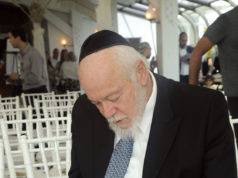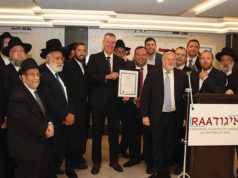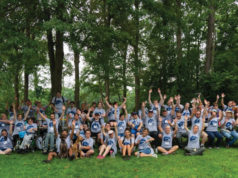
Western Jews do not always imagine that people of different skin colors, from distant cultures, could be Jewish. The truth is that there are currently indigenous communities observing traditional Jewish rituals all over the continent of Africa. True, most Jewish communities in Africa bear little resemblance to Jewish communities in Europe or North America—they look different, speak different languages, embrace music and culture with which many Western Jews are unfamiliar—yet these communities have religious practices that everyone who is Jewish would recognize.
Each community that practices Judaism in Africa has come to the religion in a different way. Some believe themselves to be descendents of the “Lost Tribes of Israel,” others are members of communities that have been Jewish for two millennia, while other groups have accepted Judaism in recent years because it is the religion that most resonates with their lives. The one factor that unifies these communities is that they are proud to call themselves Jewish, and would like the international Jewish community to accept them as Jews.
The Abayudaya of Uganda
In Eastern Uganda, near the city of Mbale in the shadow of Mount Elgon, the Abayudaya Jews live as Ugandans always have, supporting themselves through subsistence farming and struggling against the elements to bring in the next harvest. These rural Ugandans share much with their neighbors; the surrounding fields bursting with mango trees, sugar cane, banana trees and cassava, the frequent communal festivals to celebrate birth, marriage and death, the uncertainty of rapidly changing national politics and the exhaustion of poverty. A significant difference between the Abayudaya and their countrymen is that when they raise their heads to the heavens in prayer, they are praying to the G-d of Israel. They set themselves apart through devout Judaism and their adherence to the belief that some day they will become an accepted part of the international Jewish community.

In 1992, Matthew Meyer, a Brown University student studying in Kenya, heard of the Abayudaya and traveled to Mbale to spend the Sabbath with them. He returned to the United States with photographs, cassettes of the community choir singing Hebrew prayers to African melodies and letters from Abayudaya community members in both English and Hebrew. Since then, a delegation from Kulanu and a handful of other English-speaking travelers have visited the Abayudaya, bearing gifts such as a new Torah and money from the Brown University Hillel to build a synagogue.
Most members of the Abayudaya community are devout in their observance of Jewish customs and rituals. The Abayudaya’s Judaism begins from birth, when males are circumcised on the eighth day. Abayudaya children grow up with a distinct awareness that they are Jews. They sing Jewish songs, some in the local language of Luganda, others in Hebrew with African melodies. They tag along at their mother’s heels as she cleans and cooks for Shabbat. From birth the children also accompany their parents to services, both on holidays (the Abayudaya observe the same holidays as Western Jews), and weekly for Shabbat.
Almost all Abayudaya attend Shabbat services. Most Abayudaya keep kosher according to Talmudic law. They slaughter their own animals according to Jewish custom and will not eat pork. The Abayudaya keep a respectful distance from non-Jews in matters of religion, but they mingle with their neighbors at home, in the market, and in all other areas of public life.

The House of Israel Community, Ghana
In 1976 a Ghanaian man named Aaron Ahomtre Toakyirafa had a vision. Sitting deep in the Ghanaian bush, in the village of Sefwi Sui, far away from the mainstream of the international Jewish community, Toakyirafa “spoke with spirits” which inspired him to believe that he and his fellow villagers were descendants of the lost tribes of Israel.
Toakyirafa realized that the traditions of his ancestors were very similar to traditions of ancient Jews. The Sefwi strictly adhered to a Saturday day of rest. Community leaders punished members who broke the prohibition against work on the day of rest, sometimes even with death. Members of the Sefwi community followed dietary restrictions that forbade them from eating pork. Male community members were circumcised in youth; women in the community were forced into isolation during their menstrual periods, just as ancient Jews were according to the Torah. As Toakyirafa did more research he became more and more convinced that his Sefwi ancestors had a direct connection to ancient Jews.
The Lemba of Southern Africa
According to tribal lore, the Lemba are descendants of attendants to King Solomon who traveled to Ophir (Zimbabwe) in search of gold. The Lemba allege that when Solomon returned, some of his men remained, teaching the Africans to worship “Mwali,” a single G-d and spreading their traditions throughout the region. Are the Lemba direct descendants of Jews from King Solomon’s court?
They maintain that their traditions are of Jewish origin. Their flag features a Star of David and the Elephant of Judah. They practice circumcision. They bury their dead in accordance with Jewish traditions. They hold the first day of the new moon sacred, shaving their heads to commemorate it. They do not eat meat from pigs and women must purify themselves ritually after menstruating or giving birth.
The Beta Israel of Ethiopia
The central legend of Beta Israel Judaism is the story of King Solomon and Queen Sheba. The African Queen Sheba went to Solomon and shared his bed, returning to Abyssinia carrying his son. When Sheba’s son, Menelik, became curious about his father he traveled to Israel where he visited Solomon. Upon leaving, Menelik stole the coveted Ark of the Covenant, bringing it back with him to the Abyssinian capital of Axum. Thus, according to the Ethiopian Jews, Axum became the true center of Zion. Some historians believe that the true ancestor of the Beta Israel is not the legendary son of Solomon and Sheba but Dan, progenitor of one of the Lost Tribes of Israel, who migrated through the Nile valley to the ancient African kingdom of Cush. Others believe that they are not genetic descendants of Israel but that they adopted Judaism well over 2,000 years ago as either Yemenite or Egyptian traders flooded the Horn of Africa.
The Western Jewish community rejected the idea that the Beta Israel had any real claim to Hebrew lineage. Nineteenth century Jewish scholar Joseph HaLevy and his pupil, Jacques Faitlovitch, were almost alone in bringing the Beta Israel cause to the Jewish community. Their unrelenting crusade to convince Orthodox rabbinate to recognize the Beta Israel community culminated in the 1973 decree by Israel’s Sephardic Chief Rabbi, Ovadia Yossef, that that they were descendants of the Tribe of Dan and should be allowed to emigrate to Israel under the Law of Return, Israel’s immigration statute that guarantees citizenship to any “verifiable” Jew. In 1975 his Ashkenazi counterpart, Rabbi Shlomo Goren, concurred, and soon thereafter the Israeli Parliament agreed.
A few Beta Israel began to migrate to Israel in the ’70s and early ’80s, but the real emigration came in 1985 when Israel airlifted 15,000 Jews out of the midst of a harsh Ethiopian civil war in Operation Moses. Three months later, Operation Sheba brought 500 more. Israel’s airlifts have been successful in transporting the bulk of Ethiopian Jewry out of the war-torn nation, but there are still several thousand Ethiopians who claim Jewish ancestry in a compound in Addis Ababa and in small villages around the traditionally Jewish region of Gondar, along the Sudanese border. The Beta Israel’s Judaism is often difficult for other contemporary Jews to understand. The Beta Israel lost contact with the Western world more than a century before the completion of the Talmud. They therefore base their rituals directly on the Torah. Their spiritual leaders are not rabbis, but cahenats, priests who conduct high religious ceremonies and claim descent from Moses’ brother Aaron. The center of Beta Israel life is the mesgid, the synagogue. In the courtyard of the synagogue there is a stone altar for the offering of animal sacrifices. The Beta Israel pray in the morning and the evening. The Sabbath is an essential part of Beta Israel ritual. After they cease work on Friday at midday, every member of the community purifies him or herself by either visiting the mikveh or changing into a special suit of Sabbath clothing. Community members spend most of the Sabbath in the mesgid and may not light fire, draw water or leave the village.
They celebrate festivals according to a lunar calendar exactly as the Torah prescribes. On Passover the cahenats offer up a sacrifice and community members eat unleavened bread for seven days; on Rosh Hashanah, known as Berhan Sarak (The Light Shone), and Yom Kippur, (The Pardon), the cahenats make sacrifices as is written in the Torah. Beta Israel fast on Yom Kippur and cleanliness is an essential part of their ritual.
The Beta Israel don’t eat raw meat like other Ethiopians, and only eat cooked meat if a cahenat has slaughtered the animal according to particular rituals.
Morocco
Jews first appeared in Morocco more than two millennia ago. The first substantial Jewish settlements developed in 586 BC when Nebuchadnezzar destroyed Jerusalem. The community grew as an outpost of Palestine, maintaining close ties with the Jewish homeland. The Jews lived in relative tranquillity, allowed to maintain their status as a distinct nation. However, after Constantine made Christianity the law of the land in the 4th century AD the Romans started making laws against the Jews. Byzantine Emperor Justinian solidified these laws, and held Jews in contempt until the Muslims conquered the land in the 7th century.
Later, Muslims forced urban Jews to live in ghettos called mellahs, which were crowded, filthy, poverty-stricken areas traversed by narrow corridors and dark, uninviting passageways. As a result of this segregation the Jews educated their own, leading to a high literacy rate, much higher than that of the Muslim community. Some Jews were able to use their intellectual abilities to excel in business, further separating themselves from the rest of society.
The Moroccan Jewish community experienced a population explosion in the 15th and 16th centuries as Inquisition exiles fled from Spain and Portugal. The Spanish Jews were very different from the North African Jews, but they tolerated each other, sharing both customs and meager resources. Ottoman Turks tolerated the Jews but did them no special favors. When most Moroccan Jews welcomed the French declaration of the Moroccan Protectorate 1912, frustrated Muslims reacted by massacring Jews in the Fez mellah. Jews became Moroccan citizens under the Protectorate, though they were not afforded political equality. A fierce independence rebellion broke out in 1947 on the heels of subsequent Vichy French and Allied occupations of North Africa. The independence movement succeeded in 1955. As Morocco’s new Muslim government became more friendly with the Arab League, the Jewish position grew more uncertain; Jews tried to escape from Morocco but government troops captured and jailed them. In 1961 King Hassan II gave the Jews the right to emigrate, and a substantial percentage did.
Today there are several thousand Jews in Morocco, most of whom live in Casablanca. There are pockets of Jews in cities like Fez, Rabat and Marrakesh. Contemporary Moroccan Judaism is a blend of Oriental, Berber, Arab and Spanish customs, resulting in a variety of practices that combine rabbinical teachings with a devotion to spiritualism.
Talmudic scholars like Rabbi Akiva traveled extensively in North Africa, spreading Jewish scholarship to all parts of Morocco. The synagogue was the center of activity in the Moroccan Jewish community. Each community had a chief rabbi who preached, taught Judaism and gave advice; the cantor would lead the congregation in prayer. Each Jewish community had its own rabbinical court which had some autonomy over Jewish law and was sometimes able to negotiate with authorities to soften anti-Semitic proclamations.
Tunisia
Jews in Tunisia have always tread a precarious path between social acceptance and oppression. From their first documented appearance in the 2nd century to their current status as a tolerated minority, Tunisian Jews have been subject to shifts in regional and international politics that have dictated the relative security of their community.
Today, the island of Djerba is a center of Jewish spiritualism, one of the few places where scribes still hand print the Torah and community elders chant the words of the Zohar, Judaism’s book of mysticism. Most of the Djerban Jews still live as they have for centuries, surviving by metalworking and jewelry-making, maintaining strict and spiritual Jewish practices.
The Jewish community of Tunisia originated as home to scholars exiled from Palestine. Jews lived openly in Tunisia, albeit as second-class citizens, until the Spanish invasions of 1535-1574 chased Jews inland once again. The Jewish community returned to the coast under Ottoman rule and thrived under French rule until 1940, when Vichy subjected them to anti-Semitic laws. In 1942 Germans overran Tunisia, deported much of the Jewish population to labor camps and seized their property.
The Tunisian Jewish community rebuilt itself through a decade of Allied rule until the country achieved independence in 1956. The new Muslim government eliminated the Jewish rabbinical tribunal and Jewish community councils, destroying the Jewish quarter of Tunis. After the Six-Day War in 1967, Muslims laid waste to the Great Synagogue of Tunis; much of the Jewish population fled to Israel throughout the 1970s and ’80s, leaving a dedicated community of about 2,000 Jews, primarily in Tunis and on the island of Djerba in the towns of Hara Keriba and Hara Sghira, where Jews have been worshipping at the El Ghirba Synagogue for almost 1,900 years.
Today the Tunisian government watches the Jewish community closely but does not restrict Jewish practices. There are five rabbis in Tunisia; there are even several kosher restaurants in Tunis and on Djerba, where most of the community members keep kosher.
Religious life in Djerba is, as it has been for over two millennia, traditional, devoted and serious. There are 15 active synagogues and most fill every Shabbat and on holidays with tallit-clad men praying in thick Sephardic Hebrew. The synagogues are ornate structures, full of stained glass and towering archways, plastered with intricate turquoise tile. In Djerba’s Sephardic tradition the bimah is in the center of each synagogue. Men gather about the bimah and chant the prayers in unison from dense Hebrew siddurim. Djerbans are dedicated to their religion and follow Jewish traditions, including kashrut and all of the holidays, devoutly.
South Africa
The white South African Jewish community is the largest, most affluent and most Western Jewish community on the continent. Most white South African Jews are of European origin, hailing primarily from Britain, Germany and Lithuania. In the century that they have lived in Africa, members of the community have been active in all areas of the nation’s politics.
South African Jews spent the first half of the 20th century trying to find their place in the white community, appealing alternately to British and Afrikaner leaders for political recognition. Both the British and Afrikaners exhibited substantial anti-Semitism and kept them on the edge of white society.
Eventually, many South African Jews emigrated to the newly-formed state of Israel. South African Jewry had always demonstrated strong Zionist characteristics, and despite its overt anti-Semitism the South African government was consistent in its support of Israel. Some historians suggest that the South Africans, both Jewish and non-Jewish, felt a kinship with Israel, a primarily white nation born on the land of unwilling non-whites.
Jewish emigration increased in the ’50s as blacks started to rebel against apartheid en masse. Jews were active on all sides of the apartheid struggle, some in support of racial separation, others standing with Nelson Mandela.
The peaceful end of apartheid in the early ’90s had a stunning effect on South African society. South African Jews helped rebuild their country through their community’s involvement in social welfare projects and public support of African National Congress attempts at racial reconciliation; the end of apartheid symbolized an end of the white government’s institutional anti-Semitism. Still, many South African Jewish leaders expressed their uncertainty at living in a new, uncharted nation in which the crime rate rose as the income level for whites decreased. There was a substantial transmigration in South African Jewry in the ’90s; many South Africans who fled to Israel during the turbulent years have returned, but more and more of their children have chosen to migrate abroad to find jobs and higher education.
_________________
This information came from mindspring.com, courtesy of Jay Sand.



